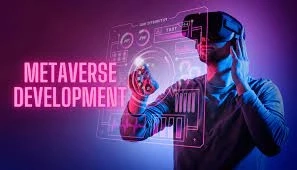The Metaverse, a virtual reality space where users can interact with a computer-generated environment and other users, is rapidly evolving, fueled by cutting-edge technologies. Here are seven top technologies driving Metaverse development:
Virtual Reality (VR) and Augmented Reality (AR): VR and AR technologies provide immersive experiences by overlaying digital content onto the real world (AR) or creating entirely virtual environments (VR). These technologies form the foundation of the Metaverse, enabling users to engage with rich, interactive environments.
Blockchain: Blockchain technology ensures secure transactions, ownership of digital assets, and transparent governance within the Metaverse. It enables decentralized virtual economies, where users can buy, sell, and trade digital goods with confidence.
Artificial Intelligence (AI): AI powers intelligent NPCs (non-player characters), procedural content generation, and realistic simulations within the Metaverse. AI-driven agents enhance user experiences by providing dynamic, responsive interactions and personalized content.
Spatial Computing: Spatial computing combines VR/AR with advanced sensor technologies to understand and interact with the physical world in real-time. This enables seamless integration of digital content into physical spaces, blurring the line between the virtual and real worlds.
3D Graphics and Rendering: High-fidelity 3D graphics and real-time rendering technologies create visually stunning environments and lifelike avatars in the Metaverse. Advanced rendering techniques, such as ray tracing and photorealistic lighting, enhance immersion and realism.
Edge Computing: Edge computing brings processing power closer to the user, reducing latency and enabling real-time interactions in the Metaverse. By distributing computational resources across edge devices, Metaverse applications can deliver seamless experiences across diverse devices and network conditions.
Interoperability Protocols: Interoperability protocols enable seamless connectivity and cross-platform experiences within the Metaverse. Standards like OpenXR facilitate interoperability between different VR/AR hardware devices, while protocols like Web3 ensure interoperability between virtual worlds and decentralized applications.
These technologies are driving the development of a vibrant, interconnected Metaverse, offering endless possibilities for social interaction, entertainment, commerce, and collaboration in virtual spaces. As these technologies continue to advance, the Metaverse will become an increasingly integral part of our digital lives.


